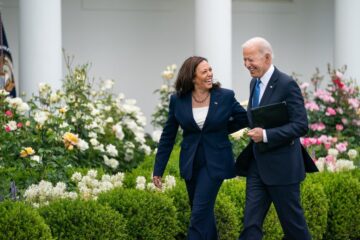Welcome back to Week 27 in my weekly reports analyzing the Covid-19 pandemic and its effects on the country and higher education. For those of you reading this on my blog, Off the Silk Road, I have also launched a newsletter, where these reports can be sent directly to your email each week. Click here to subscribe.
Last week, we discussed our failure to contain the pandemic by Dr. Peter Hotez’s prescribed October 1 deadline and examined what colleges need to do for a successful start to the spring. This week, we will attempt to paint a troubling picture of the pandemic spreading across the U.S. and discuss how higher education can prepare for the spring.
A national look
I would first like to congratulate New Zealand Prime Minister Jacinda Ardern on her and her party’s re-election. Good leadership has its rewards. The U.S. has neither.
America is tired. “Pandemic fatigue” has set in as we struggle (again) to control a rise in cases. Here’s the deal: none of the numbers are trending in the right direction. In order to best demonstrate the level of concern, I have decided this week to let the numbers and graphics speak for themselves. This set of visualizations posted by Yale epidemiologist Gregg Gonsalves shows the beginning of not only a surge in cases, but also in hospitalizations as well.
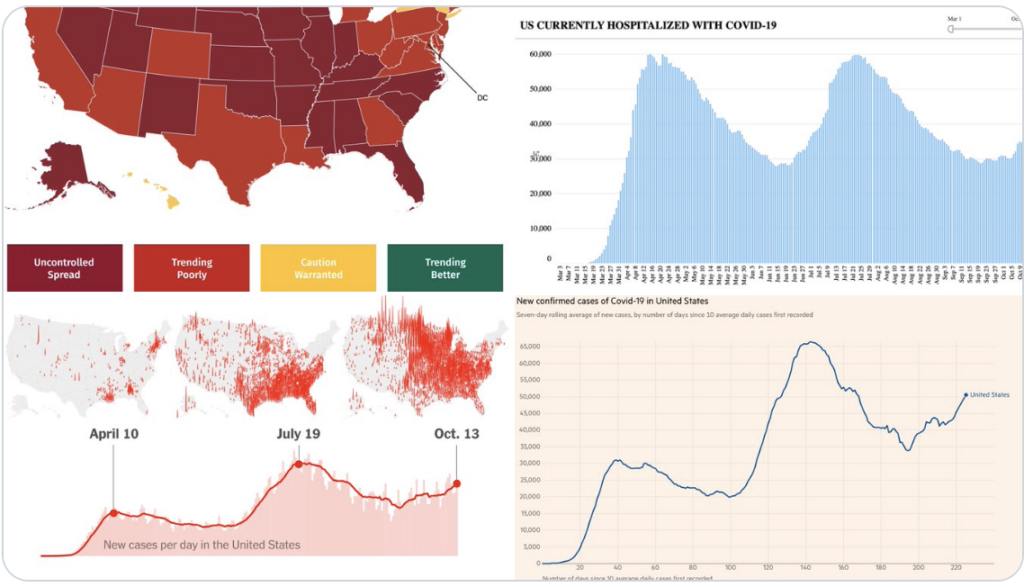
Here’s the problem with a surge in hospitalizations: many hospitals are already at capacity — some hospitals in Kansas have already started to divert incoming ambulances. This new surge, originating in the Midwest and now extraordinarily widespread, is a huge issue in many counties in the Midwest, which do not have hospital capacity in the first place. This map overlays hospital beds per 100,000 residents and new Covid-19 hotspots. Even more problematic is that many counties in the Great Plains do not have any hospitals nearby.
In addition, according to recent HHS data, many hospitals around the country are already close to capacity without an influx of Covid-19 patients. In many areas, the healthcare system is already overwhelmed.
Unfortunately, many of those hospitalized will lose their lives to Covid-19. We cannot become numb to the fact that between 700 and 900 Americans are dying every day. One newspaper in Iowa decided to devote a whole section to mourning the lives lost in the state.
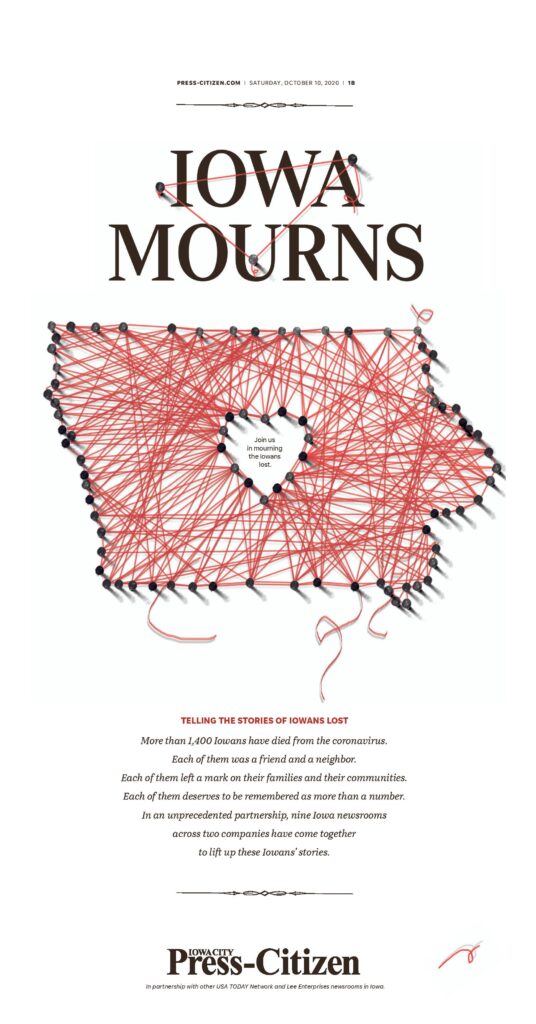
From the start of the pandemic in the U.S., politics has dominated the public health response. While many of the new cases in the spring occurred in “blue” states, “red” states now lead the country in cases per capita, as seen in this interactive visualization.
President Trump’s only current goal is to win re-election. When we look at six key battleground states (Arizona, Florida, Michigan, North Carolina, Pennsylvania and Wisconsin), cases are all on the increase. I know I’m not a political strategist, but if I can offer my two cents…sick people and winning states do not exactly go well together. To quote Dr. Jonathan Reiner earlier in the week, “It’s the virus, stupid!”
President Trump has also contributed to the spread of the virus nationwide by promoting misinformation and holding large campaign rallies. One analysis published in STAT shows increases in counties where Trump has held rallies in the last few weeks.
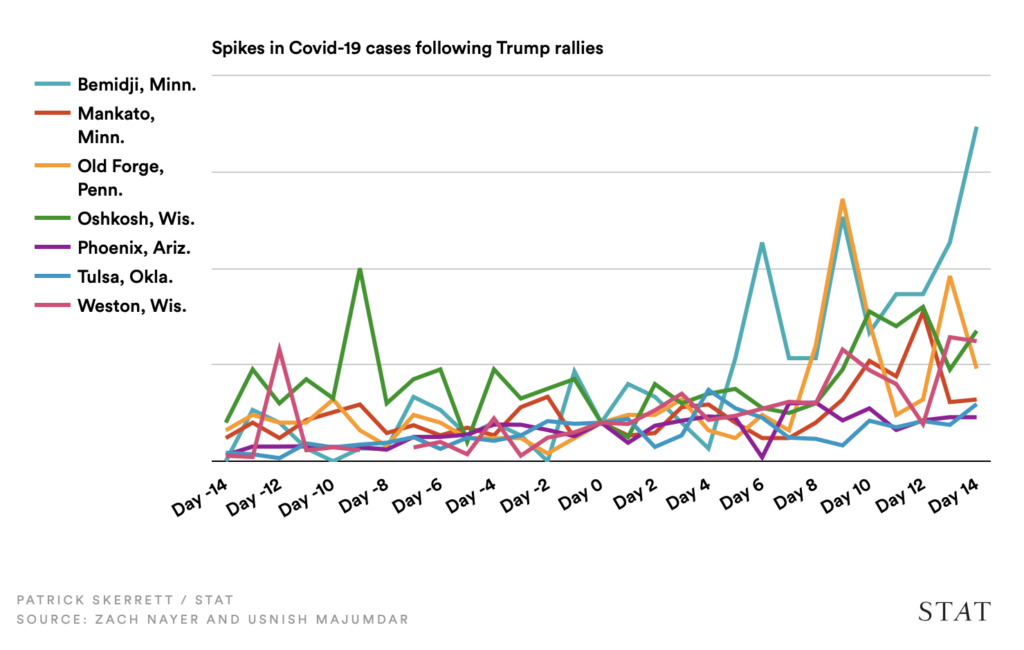
This virus is now extremely widespread in rural and urban areas, fueled by small gatherings of family and friends without masks, according to CDC Director Dr. Robert Redfield. As seen in these charts, rural areas now constitute a constantly growing proportion of new cases.
The CDC, muzzled by the president and his administration, has failed the American people. The White House now even opposes expanding testing, a “plan” promoted by radiologist and unofficial “adviser” to the president Dr. Scott Atlas. One of the most recent dangerous developments is the adoption by the White House of the Great Barrington Declaration, a statement written by scientists who argue that the U.S. could achieve “herd immunity” at 20-40% of the population infected. This “focused protection” strategy, according to the authors, would allow the U.S. to protect the most vulnerable while letting others go about their daily lives. The WHO has said that herd immunity is a term used for mass coverage through vaccination and not through natural infection. If the White House cannot protect a 74-year-old president from contracting Covid-19, how would you expect it to protect America’s most vulnerable? This “strategy” is unethical, deadly and must not be implemented. Dr. William Haseltine, Chair and President of ACCESS Health International, said that “herd immunity is another word for mass murder.” Leading epidemiologists and medical experts have signed onto the John Snow Memorandum, a statement on the scientific consensus and what we must do to keep safe without infecting large swathes of the population. “The evidence is very clear: controlling community spread of COVID-19 is the best way to protect our societies and economies until safe and effective vaccines and therapeutics arrive within the coming months,” they write. “We cannot afford distractions that undermine an effective response; it is essential that we act urgently based on the evidence.”
As we have seen over the past few months, the President of the United States presents a clear and present danger to the health of the American people. “In the past four years, however, they have been imperiled like never before by a president who places no value on science. Or data. Or facts. Or truth,” New York Times opinion writer Jeneen Interlandi writes. “He’s a president who muzzles credible scientists and amplifies charlatans.” We are just two weeks out from the election, and we cannot afford to lose more American lives to a virus on which the administration has simply given up. We thought that President Trump would lead the American people after his own Covid-19 diagnosis. He failed us. He has even held rallies this week in America’s hotspot counties. “I hope that my experience shows my fellow citizens that you should follow C.D.C. guidelines in public no matter where you are and wear a mask to protect yourself and others,” former New Jersey Governor Chris Christie said after spending days in the ICU. The president has done none of this — he continues to undermine the science and put lives at risk for his own personal gain.
Let’s take a look at some of the latest scientific developments:
- Two reports this week published in JAMA focus on excess deaths in the U.S. and other countries: one found 225,530 excess deaths in the U.S. from March to July, of which 150,541 (67 percent) were directly attributed to Covid-19. In other words, 74,989 more people died this year than usual and these deaths did not have Covid-19 as the main cause. The other report found the United States has the worst death rate (27 per 100,000) of any of the countries analyzed.
- While reinfection appears to be rare, one report found a reinfection in a 25-year-old man, with the second round bringing more severe symptoms.
- The Lancet wrote another piece describing the impressive efforts of testing and tracing and other measures in New Zealand, which enabled it to bring the epidemic under control.
- A Department of Defense study shows the possibility of contracting Covid-19 through aerosol transmission on airplanes. Researchers found that it would take 54 hours sitting next to an index case to be infected by aerosols.
- Masks work! A spin class in Canada and a hockey game in Florida show the risks of athletic activity without masks.
- A new CDC report found that the South had 45% of Covid-19 deaths from May to August.
- A new preprint found that the virus remains infectious longer at low temperatures and extreme relative humidities, which are perfect conditions for winter.
- One study out of the UK found that in a series of low-risk individuals who contracted Covid-19 (few had pre-existing conditions and few required hospitalization), almost 70% of individuals have impairment in 1 or more organs 4 months after initial symptoms, underscoring the dangers of “long haulers.”
- A fascinating preprint out of La Crosse, Wisconsin used genomic sequencing to analyze outbreaks at three colleges and found that rapid spread among the college community, not a multitude of imported cases, contributed to viral transmission. In addition, off-campus and on-campus boundaries are blurred and the virus spread into two skilled nursing facilities, resulting in two fatalities. Colleges and their communities are intertwined.
Finally, some updates on vaccines.
- The study of Johnson & Johnson’s Covid-19 vaccine has been paused due to an unexplained illness in a study participant.
- China has started vaccinating portions of its population with its unproven vaccine.
- The CEO of Pfizer has said assuming positive data, he expects his vaccine to apply for emergency use authorization in late November (weeks after the election).
- The Department of Health and Human Services announced a deal with CVS Health and Walgreens to administer coronavirus vaccines to the elderly and staff in long-term care facilities.
- Dr. Anthony Fauci will now see data from government-funded vaccine trials before the FDA does.
So what are we going to do about all this? Brown University emergency room physician Dr. Megan Ranney has devised five simple guidelines for all of us to follow and keep our fellow Americans safe.
- If you feel sick, stay home.
- Always wear a mask when with people who aren’t in your household.
- A negative Covid-19 test is not carte blanche to do whatever you want from the day onwards.
- Avoid indoor events whenever possible – especially ones with singing, physical activity, or shouting. (If you must be indoors, wear a mask.)
- Be nice. Help out your neighbors. Help out people you don’t even know.
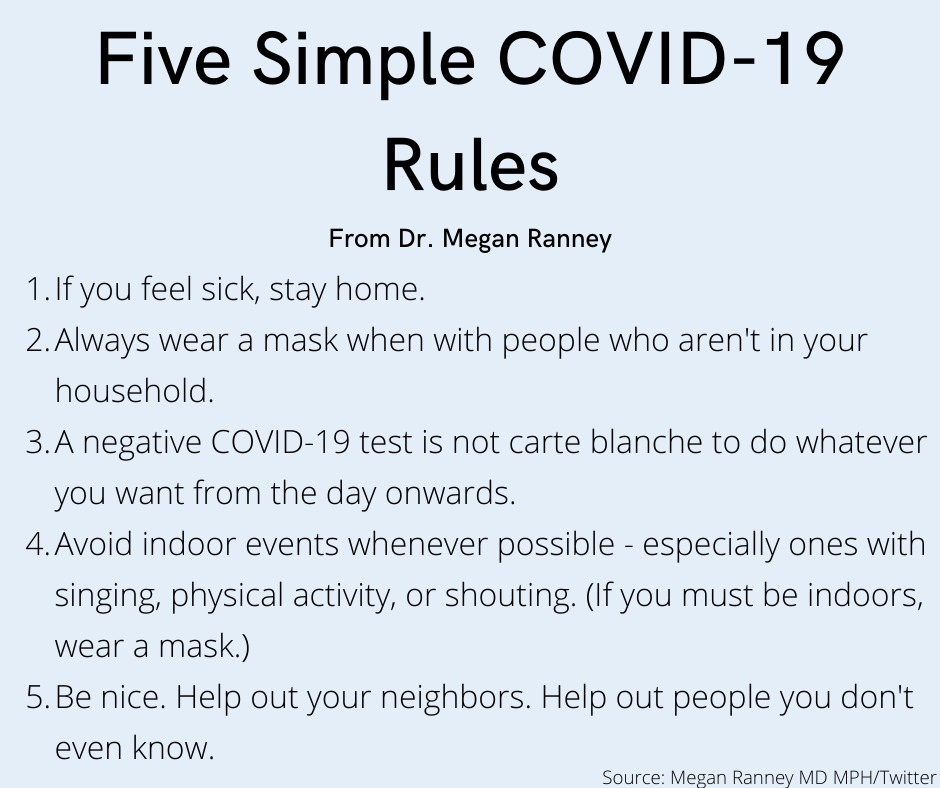
It is up to all of us to follow these guidelines.
Let’s move on to our discussion of higher education.
Higher education
Each Friday, I update the College Watchlist, which is Currently tracking 104,746 total cases at 92 colleges. At the top of my list of cases in the last 7 days are:
- Clemson University – 260
- University of Florida – 219
- University of Central Florida – 218
- Miami University-Oxford – 204
- Brigham Young University – 156
Through quarantines and twice-weekly testing, colleges continue to persevere through the last few weeks of the fall semester before Thanksgiving (slowing transmission before Thanksgiving is another issue, and one we will tackle in the coming weeks). According to new data from Overall, the National Student Clearinghouse Research Center, undergraduate populations shrank by 4% this fall and first-year student counts fell by 16.1%.
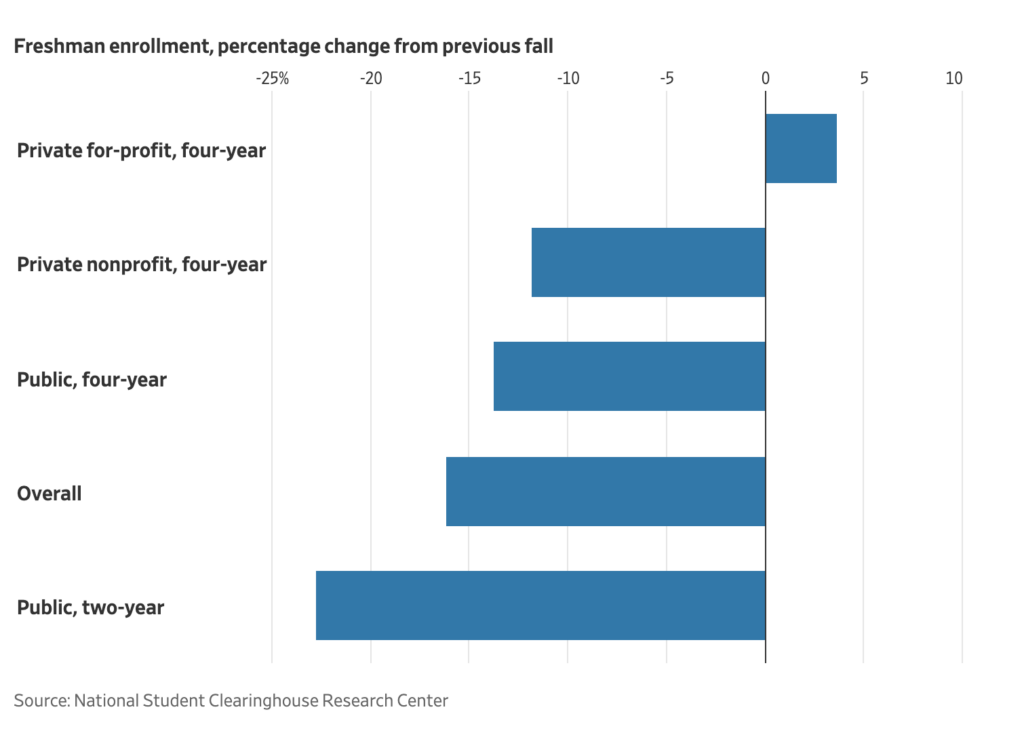
Here is a roundup of the latest higher ed news.
- An article published in Kaiser Health News exposes the challenges of counting college cases for county dashboards and contact tracing purposes, as some students put their home addresses on their Covid-19 tests. It serves as a reminder that even if college dashboard cases may be decreasing, tests off-campus may show a different picture.
- In a survey conducted by its student newspaper, 86% of students at CU-Boulder rated the overall university response as “poor” or “very poor.”
- One line in a White House Coronavirus Task Force report for Georgia said that based on the number of symptomatic college students, between 15-20% of all college students in the state may have been infected.
- The president of SUNY Oneonta abruptly resigned late last week after more than 700 students tested positive for the virus earlier in the semester, the worst coronavirus outbreak of any public university in New York.
- One NPR Short Wave episode focused on the University of Illinois and its robust testing program, which allows the university to collect immense amounts of data on viral spread. The university has found that 95% of cases have occurred in undergraduates and the virus is not spreading in classrooms. Additionally, contact tracers notify contacts within 30 minutes of positive results.
- “I would always be happy if we had 100% of students tested weekly,” Dr. Deborah Birx said at Penn State earlier this week. “Because I think testing changes behavior.”
- My colleagues Claire Hao and Jack Grieve uncovered an outbreak in the University of Michigan‘s Greek life, as well as discovering freshmen conducting recruiting against university policy.
- Clemson University now has the highest number of Covid-19 cases out of any U.S. college, now at 4,460. Assuming that each student has been tested no more than once, 16% of the student body has been infected.
- My colleague Annabelle Williams wrote a fantastic piece on dating on a college campus in the age of coronavirus.
- The Broad Institute has distinguished itself as a testing leader for colleges, with a turnaround time of around 14 hours.
- Covid-19 has hit the college athletics world, with Alabama coach Nick Saban and Florida coach Dan Mullen testing positive, a week after Mullen expressed the desire for 95,000 fans at a game.
- Harvard epidemiologist Julia Marcus and a team of health experts have written an open letter to college administrators on regulating behavior. “This abstinence-only approach to social contact is inhumane, unrealistic and likely to backfire,” they write.
We must ensure that despite surges in many parts in the country, our colleges remain safe until students return home for Thanksgiving. Colleges in some areas may need to tighten restrictions as a precautionary measure.
The Good Stuff
Let’s roll the clips of the good stuff. In my usual tradition, I feature my favorite stories from the week. Here are my Top 10.
- A 77-year-old terminally ill man in Michigan cast a ballot as his final mission.
- New York Governor Andrew Cuomo was interviewed with his daughters on their lives together during the pandemic.
- The Nobel Prize committee couldn’t reach Stanford professor Paul Milgrom to share the news that he won, so his fellow winner and neighbor Robert Wilson knocked on his door in the middle of the night.
- Remote work has given America’s CEOs a taste of a different way to live.
- The Washington Post’s sports columnist bids farewell to the NBA bubble.
- Why is it still so hard to find a can of corn? The Wall Street Journal delves into supply chain issues.
- Some of Hollywood’s studios have resumed film production with precautions.
- Business Insider’s Grace Panetta provides all the information you need for Election Day.
- College sports will halt on Election Day so athletes can vote. That means you should too!
- A beach town in Massachusetts begged its residents to stop panicking after reports of a stranded sunfish that looked like a shark.
Conclusion
Call it a surge or a wave, it’s here. All of the numbers are trending in the wrong direction and if we fail to take action, this could be the deadliest winter in our recent history. “Trump claims to put ‘America First’. But in his response to the pandemic, Trump has put himself first, not America,” the science magazine Nature writes in its endorsement of Joe Biden. “[He] has demonstrated that he can neither lead nor unite the United States.”
We know the public health tools that work. In the absence of a federal leadership, we need to exert all our power to keep each other safe. America is in crisis. Vote like your life depends on it, because it does.
I’d like to thank all the student journalists with whom I have the pleasure of working. In the next weeks and months ahead, they will become vital in chronicling their colleges’ paths forward for the fall and beyond. Support their work by reading it.
My best to all for good health.
Like what you see? Don’t like what you see? Want to see more of something? Want to see less of something? Let me know in the comments. And don’t forget to subscribe to the weekly newsletter!
For more instant updates, follow me on Twitter @bhrenton.

